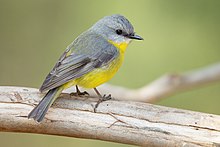| Songbird Temporal range: Early Eocene to present
| |
|---|---|

| |
| Eastern yellow robin (Eopsaltria australis) | |
| Song of a chipping sparrow (Spizella passerina) | |
| Scientific classification | |
| Domain: | Eukaryota |
| Kingdom: | Animalia |
| Phylum: | Chordata |
| Class: | Aves |
| Order: | Passeriformes |
| Clade: | Eupasseres |
| Suborder: | Passeri Linnaeus, 1758 |
| Clades | |
|
Menuridae | |
| Synonyms | |
|
See text | |
A songbird is a bird belonging to the suborder Passeri of the perching birds (Passeriformes). Another name that is sometimes seen as the scientific or vernacular name is Oscines, from Latin oscen, "songbird". The Passeriformes contains 5,000 or so species[1][2] found all over the world, in which the vocal organ typically is developed in such a way as to produce a diverse and elaborate bird song.
Songbirds form one of the two major lineages of extant perching birds (~4,000 species), the other being the Tyranni (~1,000 species), which are most diverse in the Neotropics and absent from many parts of the world.[2] The Tyranni have a simpler syrinx musculature, and while their vocalizations are often just as complex and striking as those of songbirds, they are altogether more mechanical sounding. There is a third perching bird lineage, the Acanthisitti of New Zealand, of which only two species remain alive today.[3] Recent estimates indicate that songbirds originated 50 million years ago.[4] The distribution of their basal lineages suggest that their origin and initial diversification occurred exclusively in the Australian continent and only about 40 million years ago, oscines started to colonize Eurasia, Africa, and eventually the Americas.[5][4][6]
- ^ IOC World Bird List 5.1. doi:10.14344/IOC.ML.5.1.
- ^ a b Edwards, Scott V. and John Harshman. 2013. Passeriformes. Perching Birds, Passerine Birds. Version 06 February 2013 (under construction). http://tolweb.org/Passeriformes/15868/2013.02.06 Archived 2022-10-31 at the Wayback Machine in The Tree of Life Web Project, http://tolweb.org/[Accessed[permanent dead link] 2017/12/11].
- ^ Barker, F. K; Cibois, A; Schikler, P; Feinstein, J; Cracraft, J (2004). "Phylogeny and diversification of the largest avian radiation". Proceedings of the National Academy of Sciences. 101 (30): 11040–5. Bibcode:2004PNAS..10111040B. doi:10.1073/pnas.0401892101. JSTOR 3372849. PMC 503738. PMID 15263073.
- ^ a b Claramunt, S.; Cracraft, J. (2015). "A new time tree reveals Earth history's imprint on the evolution of modern birds". Science Advances. 1 (11): e1501005. Bibcode:2015SciA....1E1005C. doi:10.1126/sciadv.1501005. PMC 4730849. PMID 26824065.
- ^ Low, T. (2014), Where Song Began: Australia's Birds and How They Changed the World, Tyre: Penguin Australia[page needed]
- ^ Reilly, John (2018). The Ascent of Birds. Pelagic Publishing. p. 182. ISBN 978-1-78427-203-6.